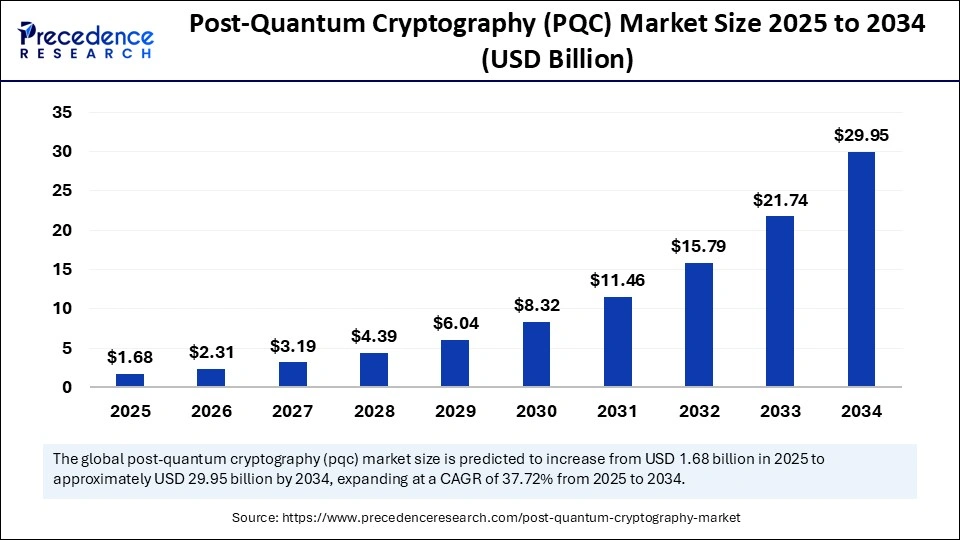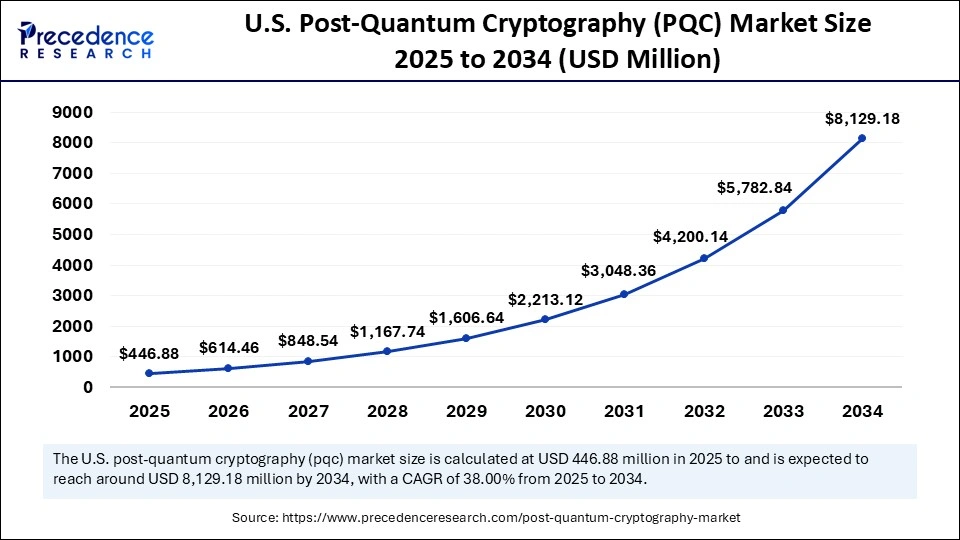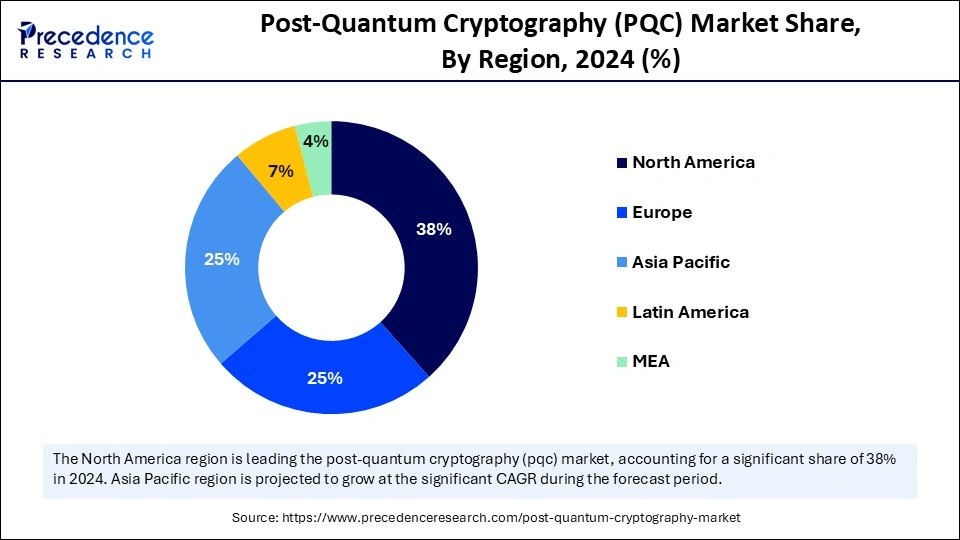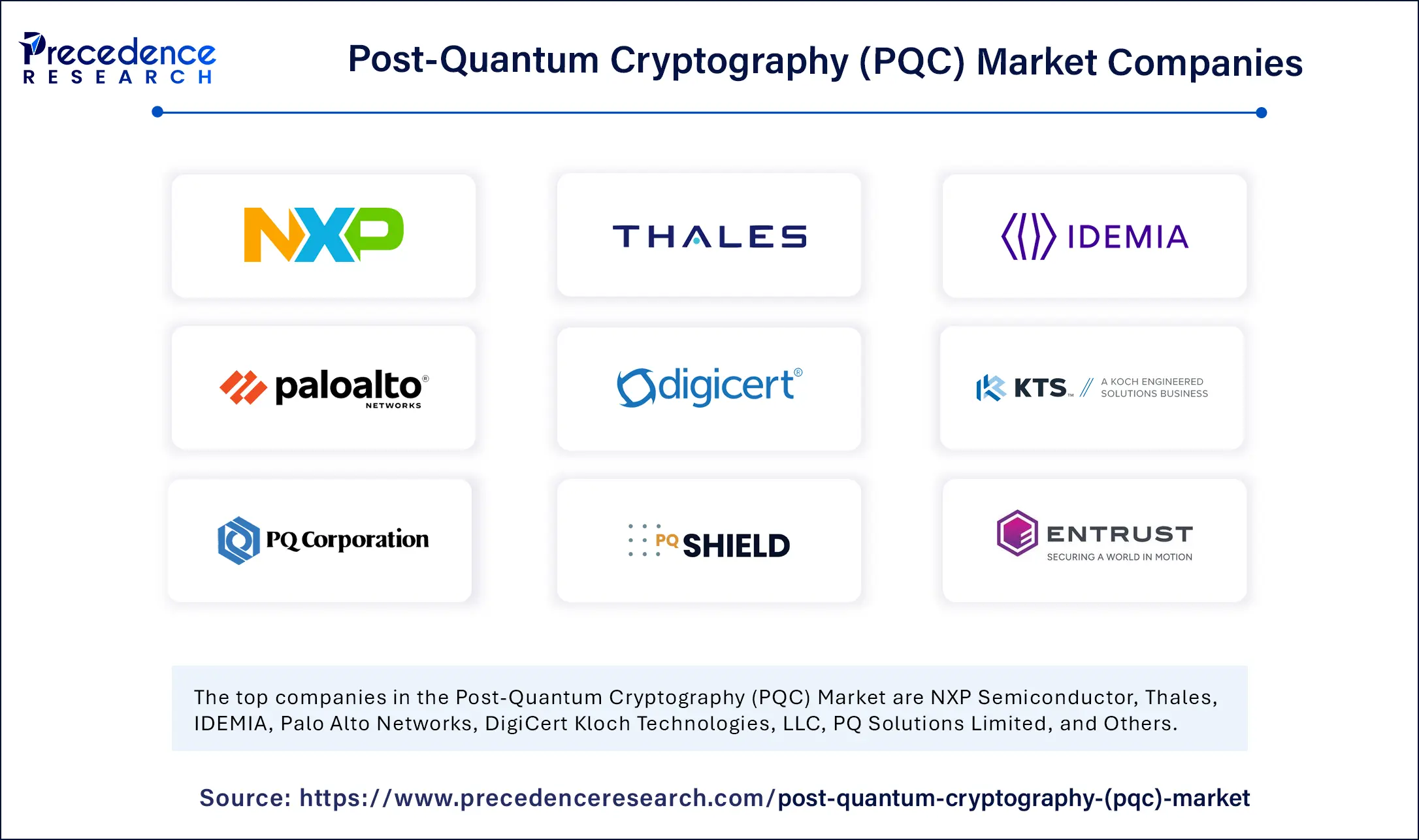List of Contents
What is the Post Quantum Cryptography (PQC) Market Size?
The global post quantum cryptography (PQC) market size is calculated at USD 1.68 billion in 2025 and is predicted to increase from USD 2.31 billion in 2026 to approximately USD 29.95 billion by 2034, expanding at a CAGR of 37.72% from 2025 to 2034. The market is expanding rapidly due to the rising R&D into quantum computing and rising concerns about data security.

Post Quantum Cryptography (PQC) MarketKey Takeaways
- In terms of revenue, the post-quantum cryptography (PQC) market is valued at $1.68 billion in 2025.
- It is projected to reach $29.95 billion by 2034.
- The market is expected to grow at a CAGR of 37.72% from 2025 to 2034.
- North America accounted for the biggest revenue share of 38% in 2024.
- Asia Pacific is expected to grow at the fastest CAGR of 40.6% from 2025 to 2034.
- By service, the design, implementation, and consulting segment contributed the biggest market share in 2024.
- By service, the migration services segment is expected to expand at a significant CAGR during the forecast period.
- By type, the lattice-based cryptography segment held the major revenue share of 49% in 2024.
- By type, the hash-based cryptography segment is expected to grow at a significant CAGR over the projected period.
- By solution, the quantum-resistant algorithms segment held the major market share in 2024.
- By solution, the quantum-safe authentication solutions segment is projected to grow at the highest CAGR between 2025 and 2034.
- By enterprise size, the large enterprises segment contributed the highest revenue share of 74% in 2024.
- By enterprise size, the small & medium enterprises (SMEs) segment is expected to expand at the fastest rate in the coming years.
- By vertical, the government and defense segment dominated the market in 2024.
- By vertical, the IT & ITES segment is expected to grow at the fastest CAGR during the projection period.
How Does AI Transform the Post-Quantum Cryptography (PQC) Market?
Artificial intelligenceis transforming the market for post-quantum cryptography by assisting in both developing and optimizing quantum-resistant algorithms, automating key management, and enhancing overall security. AI algorithms can help design and optimize PQC algorithms, improving their efficiency and security. Additionally, AI can automate tasks like key management and deploy PQC solutions, streamlining the process and reducing human error, along with analyzing the threat landscape and identifying potential vulnerabilities in PQC implementations, allowing for proactive security measures. Consequently, the overall capability of AI to analyze complex datasets, identify vulnerabilities, and automate tasks makes it an asset for navigating the transition to PQC.
Market Overview
The post-quantum cryptography (PQC) is gaining traction across various industries as a future-proof security solution against potential threats posed by quantum computers. PQC algorithms offer enhanced security compared to traditional cryptography by resisting attacks from both classical and quantum computers. They address the growing threat of quantum computers to current cryptographic systems, which are essential for securing digital communications and data. The increasing demand for secure communication in a rapidly evolving digital landscape and rising cybersecurity threats and proactive measures organizations are undertaking to safeguard sensitive data are propelling the growth of the market.
What are the Key Trends in the Post-Quantum Cryptography (PQC) Market?
- Expansion of Digital Infrastructure: The growing reliance on digital infrastructure by both private and public sectors necessitates strong cybersecurity solutions, making post-quantum cryptography essential for protecting against quantum attacks while ensuring interoperability with existing systems.
- Concern About Cybersecurity Threats: The rise in cyberattacks and the looming threat of quantum-powered attacks have heightened the demand for quantum-resistant encryption. Many organizations are leading efforts to standardize PQC algorithms, making them easier to implement and adopt.
- Demand For Future-Proofing Solutions: Post-quantum cryptography (PQC) is designed to be secure against both current and future quantum computing advancements, enabling long-term data protection to ensure data security and compliance.
- Technological Advancements: Innovations, along with ongoing research and development efforts, are propelling advancements in PQC, leading to the creation of more secure and efficient algorithms that require organizations to implement PQC solutions.
Market Scope
| Report Coverage | Details |
| Market Size by 2034 | USD 29.95 Billion |
| Market Size in 2025 | USD 1.68 Billion |
| Market Size in 2026 | USD 2.31 Billion |
| Market Growth Rate from 2025 to 2034 | CAGR of 37.72% |
| Dominating Region | North America |
| Fastest Growing Region | Asia Pacific |
| Base Year | 2024 |
| Forecast Period | 2025 to 2034 |
| Segments Covered | Services, Type, Solution, Enterprise Size, Vertical, and Region |
| Regions Covered | North America, Europe, Asia-Pacific, Latin America, and Middle East & Africa |
Market Dynamics
Drivers
Imminent Threat of Quantum Computing to Existing Cryptographic Systems
The major factor driving the growth of the post-quantum cryptography (PQC) market is the imminent threat of quantum computing to existing cryptographic systems. This includes algorithms like RSA, which are widely used for online security, and ECC, utilized in many digital signatures and data encryption. This threat, compounded by government initiatives and regulatory pressures, is driving the adoption of quantum-safe encryption. Quantum computers, if developed to a certain level, could potentially break current encryption methods by rapidly solving computationally complex problems.
In June 2025, Patero announced the launch of CryptoQoR. This new, highly efficient crypto-agile software module establishes secure communication channels and proactively mitigates security risks through hybrid post-quantum encryption. The solution can be readily deployed into existing infrastructure to enhance current cryptographic protection and immediately address risks associated with quantum attacks.
(Source: https://www.businesswire.com)
Restraint
Higher Cost of Implementation and Lack of Standardization
A significant restraint in the post-quantum cryptography (PQC) market is the higher implementation and maintenance cost of PQC systems. This includes hardware upgrades, software development, and specialized expertise, posing challenges for small and medium-sized organizations. This challenge is bolstered by the complexity of developing algorithms and software architecture. Integrating PQC into existing systems requires both expertise and time-consuming testing and validation, increasing total costs. Moreover, the lack of standardized PQC algorithms limits the growth of the market.
Opportunity
Development and Deployment of PQC Solutions for Quantum-Safe Hardware and Software
A major opportunity in the post-quantum cryptography (PQC) market lies in the development and deployment of PQC solutions for quantum-safe hardware and software, including quantum-resistant algorithms and solutions tailored for specific industries. PQC algorithms are foundational for quantum-safe encryption and other cryptographic operations, including key exchange, digital signatures, and encryption. They are specifically designed to resist quantum attacks, making them crucial for safeguarding data and communications. As quantum computing advances, existing encryption methods require the development and adoption of new, quantum-resistant algorithms.
Service Insights
Which Service Segment Dominated the Market in 2024?
The design, implementation, and consulting segment dominated the post-quantum cryptography (PQC) market with the highest revenue share in 2024. This is due to the complex nature of migrating to PQC algorithms and the increased demand for expert guidance. Organizations require customized solutions, risk assessments, and strategic planning to improve seamless transitions and compliance with evolving regulations. These services enable organizations to assess the risks associated with quantum threats and ensure compliance with emerging security standards.
The migration services segment is expected to expand at a significant CAGR during the forecast period. This is mainly due to the complex and time-consuming process of transitioning from legacy cryptographic algorithms to quantum-resistant alternatives, boosting the need for migration services. Organizations need expert assistance to assess existing systems, identify vulnerabilities, and implement PQC solutions while minimizing disruption and ensuring compliance, making specialized migration services essential.
Type Insights
Why did the Lattice-Based Cryptography Segment Dominate the Post-Quantum Cryptography (PQC) Market?
The lattice-based cryptography segment dominated the market with a major revenue share of 49% in 2024. This is mainly due to its robust security, efficient performance, and widespread standardization. It relies on the computational difficulty of solving lattice problems, which are believed to be secure against quantum attacks. It is also considered a leading approach for securing against quantum computer attacks, making it suitable for various applications.
The hash-based cryptography segment is expected to grow at a significant CAGR over the projected period. This is mainly due to its ease of use, proven security in digital signatures, and suitability for resource-constrained environments. Hash-based signatures, when using secure hash functions, are resistant to quantum attacks, making them a robust solution for digital signatures in the post-quantum era. They offer long-term security without relying on complex mathematical assumptions and are resistant to quantum attacks. This makes them well-suited for data integrity applications and secure authentication.
Solution Insights
What Made Quantum-Resistant Algorithms the Dominant Segment in the Market?
The quantum-resistant algorithms segment dominated the post-quantum cryptography (PQC) market with the highest revenue share in 2024. These algorithms play a critical role in protecting sensitive data against emerging quantum threats. The National Institute of Standards and Technology (NIST) has standardized several quantum-resistant algorithms, fostering confidence and accelerated adoption. This segment's dominance is reinforced due to the proactive adoption of PQC technologies and the realization that organizations must prepare for the transition to a quantum-safe future.
The quantum-safe authentication solutions segment is projected to grow at the highest CAGR during the predicted timeframe. The growth of the segment is attributed to the increasing risk of threats of quantum computing to traditional cryptographic methods like RSA and ECC. Quantum-safe authentication solutions address the demand to protect identity verification and data from quantum-enabled cyberattacks. PQC also offers new algorithms resistant to these threats by ensuring the integrity of authentication processes, opening the way for widespread adoption.
Enterprise Size Insights
How Does Large Enterprises Segment Dominate the Post-Quantum Cryptography (PQC) Market in 2024?
The large enterprises segment dominated the market by capturing the maximum revenue share of 74% in 2024. This is due to their significant financial resources, complex IT infrastructure, and rigorous regulatory requirements. Their extensive digital infrastructure and large amounts of sensitive data make them prime targets for future quantum-enabled cyberattacks. Moreover, they have the capital to invest in advanced PQC technologies, including hardware upgrades, software development, and professional services. Stringent regulations regarding customer data security encourage them to invest in research, development, and implementation of advanced PQC solutions, including quantum-safe hardware, migration services, and consulting.

The small & medium enterprises (SMEs) segment is expected to expand at the fastest rate in the coming years. The growth of the segment is attributed to the growing awareness of quantum computing threats and the rising demand for future-proof security solutions. PQC algorithms facilitate the ability to secure data against potential quantum attacks, a critical concern for SMEs as they handle sensitive information and customer data. Furthermore, the availability of cloud-based PQC solutions and managed security services enable smaller organizations to mitigate the risks of data breaches.
Vertical Insights
Why did the Government and Defense Segment Dominate the Post-Quantum Cryptography (PQC) Market in 2024?
The government and defense segment dominated the market with a major revenue share in 2024. This is mainly due to the heightened demand for secure communication and data protection against emerging quantum threats. PQC is primarily responsible for national security, which includes safeguarding sensitive data and communications from potential adversaries. PQC is also resistant to attacks from quantum computers, which is essential for safeguarding national security and sensitive information and ensuring the resilience of critical infrastructure.
The IT & ITES segment is expected to grow at the fastest CAGR during the projection period. This is because the IT sector relies heavily on secure data exchange, cloud computing, and digital services, making it highly vulnerable to the threat of quantum computing. This creates the need for robust security solutions. The rising frequency of cyberattacks and the expansion of digital infrastructure, which includes technologies like 5G, internet of things (IoT), and edge computing, further support segmental growth. Furthermore, its focus on protecting intellectual property, customer data, and service continuity highlights the importance of PQC.
Regional Insights
U.S. Post Quantum Cryptography (PQC) Market Size and Growth 2025 to 2034
The U.S. post quantum cryptography (PQC) market size is exhibited at USD 446.88 million in 2024 and is projected to be worth around USD 8,129.18 million by 2034, growing at a CAGR of 38.00% from 2025 to 2034.

How Does North America Dominate the Post-Quantum Cryptography (PQC) Market in 2024?
North America registered dominance in the market by holding the maximum revenue share of 38% in 2024, primarily due to the increased investments in cybersecurity solutions, proactive government initiatives, and developed technology infrastructure. North America places a high priority on cyber security by recognizing the potential threat of quantum computing to existing encryption algorithms. The presence of major technology companies such as IBM, Microsoft, Google, Intel, and Amazon, along with other key players like Rigetti Computing, IonQ, and Quantinuum, sustain the region's position in the market. Furthermore, government agencies like NIST are actively involved in developing and standardizing PQC algorithms, propelling the adoption of quantum-safe technologies.
In August 2024, the U.S. National Institute of Standards and Technology released Federal Information Processing Standards (FIPS) publications for three quantum-resistant cryptographic algorithms, serving as an inflection point in modern cybersecurity by supplying chain vendors that the time has come to make the world's information security systems resistant to future cryptographically relevant quantum computers.
(Source: https://research.ibm.com)
The U.S. Post-Quantum Cryptography (PQC) Market Trends
The U.S. plays a major role in the market within North America. Rising government initiatives to standardize PQC algorithms, private sector investments in PQC, and awareness of the quantum threat. The presence of prominent players, including tech giants like AWS and Microsoft, alongside cybersecurity firms, drives market growth. In addition, the rising frequency of cyber threats is encouraging businesses to invest in PQC to ensure data security against future threats.

What Factors Contribute to the Post-Quantum Cryptography (PQC) Market Within Asia Pacific in 2024?
Asia Pacific is poised to grow at the fastest CAGR of 40.6% in the upcoming period due to rapid digital transformation, growing cybersecurity awareness, and strong government support for quantum technology research and development. Furthermore, governments of countries like China, Japan, India, and South Korea are investing heavily in PQC development and deployment to protect critical infrastructure and sensitive data from future quantum attacks. Also, Key industries, including banking, healthcare, and telecommunications, are actively adopting PQC to comply with regulatory requirements and address cybersecurity concerns. The region is witnessing advancements in multivariate polynomial, hash-based, and lattice-based cryptographic algorithms, offering long-term data protection.
India Post-Quantum Cryptography (PQC) Market Trends
India plays a distinctive role in the market due to its strong focus on research and development through initiatives like the National Quantum Mission, which aims to advance quantum technologies, including PQC. Additionally, the Indian Army's Quantum Lab also emphasizes research and training in quantum computing and communication. The Centre for Development of Telematics (C-DOT) has developed quantum-safe products such as the Compact Encryption Module and the Quantum Secure Smart Video IP Phone, highlighting the country's support for Post-Quantum Cryptography (PQC).
What Opportunities Exist in the European Post-Quantum Cryptography (PQC) Market?
Europe is considered to be a significantly growing area. Strong government support for PQC research and development and rising cybersecurity concerns are expected to drive the growth of the market within Europe. The region boasts a strong base of research institutions and universities that are actively engaged in the research and development of PQC. Furthermore, European countries are actively investing in quantum technologies to improve national security. Stringent data privacy regulations like GDPR further support regional market growth.
Post Quantum Cryptography (PQC) Market Companies

- NXP Semiconductor
- Thales
- IDEMIA
- Palo Alto Networks
- DigiCert
- Kloch Technologies, LLC
- PQ Solutions Limited
- PQShield Ltd
- Entrust Corporation
- IBM Corporation
Latest Announcement by Industry Leader
- In March 2025, Unisys launched the first of several new Post-Quantum Cryptography (PQC) capabilities and services within its cybersecurity portfolio. The cryptographic posture assessment is part of a consistent rollout of comprehensive offerings designed to help organizations prepare for and defend against future quantum threats by providing clients with a complete inventory and analysis of their cryptographic environment. Manju Naglapur, senior vice president and general manager, Cloud, Applications & Infrastructure at Unisys, said, “Through our holistic set of services, we empower organizations to hit head-on the challenges of post-quantum cryptography, help them navigate the complexities, and create a program designed to protect their IT estate from cyber threats now and in the future."
(Source: https://www.unisys.com)
Recent Developments
- In April 2025, Utimaco announced the launch of Quantum Protect, the Post-Quantum Cryptography application package for its u.trust General Purpose Hardware Security Modules Se-Series.
(Source: https://utimaco.com) - In December 2024, General Dynamics Information Technology announced that it had joined the National Institute of Standards and Technology's Migration to Post-Quantum Cryptography (PQC) Building Block Consortium. As the first systems integrator to join this consortium, they focus on addressing the threats posed by quantum computing by developing practical solutions and tools that assist organizations in migrating to PQC, ensuring that critical digital information remains protected against future quantum-enabled threats.
(Source: https://www.gdit.com) - In August 2024, the National Institute of Standards and Technology (NIST) officially released the Stateless Hash-Based Digital Signature Standard. The SPHINCS+ algorithm is a hash-based digital signature technique that does not rely on large integer factorization or discrete logarithm problems to ensure the security of digital signatures by providing a long-term secure solution that can resist future quantum computer attacks.
(Source: https://www.sdu.dk)
Segments Covered in the Report
By Services
- Design, Implementation, and Consulting
- Migration Services
- Quantum Risk Assessment
By Type
- Lattice-Based Cryptography
- Code-Based Cryptography
- Multivariate Cryptography
- Hash-Based Cryptography
- Others
By Solution
- Quantum-Resistant Algorithms
- Quantum-Safe Cryptographic Libraries
- Quantum-Safe Authentication Solutions
- Quantum-Resistant Encryption Solutions
- Quantum-Safe VPN, Email, Messaging
- Quantum-Safe Blockchain Solutions
- Quantum-Safe Hardware
By Enterprise Size
- Small & Medium Enterprises (SMEs)
- Large Enterprises
By Vertical
- BFSI
- Retail & E-commerce
- Healthcare
- Government and Defense
- IT & ITES
- Others
By Region
- North America
- Europe
- Asia-Pacific
- Latin America
- Middle East and Africa
For inquiries regarding discounts, bulk purchases, or customization requests, please contact us at sales@precedenceresearch.com
Frequently Asked Questions
Ask For Sample
No cookie-cutter, only authentic analysis – take the 1st step to become a Precedence Research client